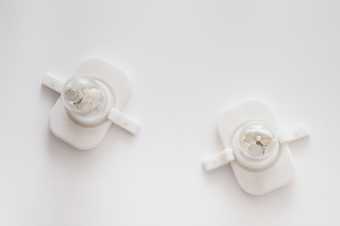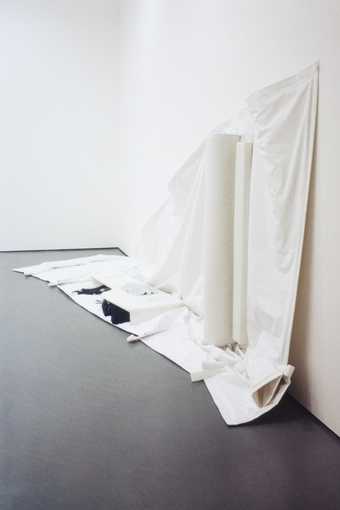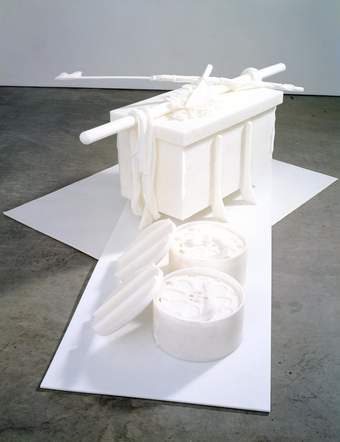Matthew Barney’s work combines sculpture, performance and video. In installations he has been making over the past five years, he introduces references from diverse cultural activities. These range from physical pursuits such as football, climbing and wrestling, to the skills of role-playing and dressing-up associated with acting or modelling. In Barney’s work dynamic performances are intended to be seen as the external equivalent of vital processes – such as digestion, oxygenation or muscle growth – that take place within the body. In Barney’s work diverse activities are combined in highly charged fictional narratives. Taking an extreme view on what constitutes artistic practice, Barney has evolved a visual vocabulary that explores the striving of the body against its inbuilt limitations, reflexes, ageing processes and memories.
Ottoshaft is one of a trilogy of works called the Jim Otto Suite, named after Jim Otto, an American football player of the 1970s. While fully self-contained, Ottoshaft is the middle section occurring at ‘half time’ in the trilogy. Although Ottoshaft was already planned when the other two parts were shown in 1991, it was made later, in the summer of 1992. The Jim Otto Suite constitutes an extended narrative based on the character and physiology of Jim Otto. It began with an exhibition in Los Angeles (with Otto playing in white ‘away’ strip) and was completed in a New York gallery (with Otto wearing the black ‘home’ strip in Barney’s home town).
Ottoshaft consists of a variety of organic materials and plastic objects, and three video films which are broadcast continuously on ceiling-mounted monitors, A sequence of puzzling, sometimes frenetic actions are recorded in the videos, which are called Ottodrone, Ottoshaft and Autodrone, Ottoshaft was originally exhibited under the curving exit and entry ramps of an underground car park in Kassel, in Germany, during Documenta, the international exhibition of contemporary art that takes place there every five years.
Barney has adapted the work for display in the Art Now room at the Tate, where it is shown in a single space divided by an ascending wall. Visitors follow a semi-circular route around the two sections of the work. Instead of a curving space for the work, Barney has now created a curving path for visitors. The floors and walls of the room are lined with a white vinyl cloth.
Ottoshaft proposes several interweaving narratives that are manifested in a set of objects, characters and identities. These narratives are connected through the bizarre but apposite image of the bagpipes. Present in Ottoshaft as a prop and as a metaphor for processes within the body, bagpipes constitute a leitmotif recurring throughout the structure and imagery of the work.
In the video films, Barney has created richly allusive fiction, which blends, in a web of metaphor and association; the ‘science’ of body-building, the game of American football with its moves, formations and field of play, and the internal functioning of the body. Connections between these diverse elements are made by an eclectic cast of characters, some of whom are named and play a part in the action. Others do not appear in the videos, but can be identified through certain characteristics. Viewed as a totality, they all constitute different facets of Jim Otto, the central character in Ottoshaft.
External conflicts are conveyed in the videos by the competitiveness of the football game – identifiable even when its training routines and touch-down runs appear to overlap bizarrely with a dress parade of the Scottish Black Watch. Of equal importance to these visible dramas, however, are the unseen bodily processes that reflect the stressful physical demands made on the active body. The absorption of nutrients, their metabolic conversion, how far the body can be pushed, are all vital narrative elements in Ottoshaft.
Pills made of glucose, sucrose, Vaseline, tapioca, meringue (containing protein) and pound cake (made of carbohydrate) are thrown and caught (like footballs) in the Ottodrone video. Partly suggesting a game in progress, they also relate to successive stages of metabolic conversion. The fully prepared, athletic physique, attained after sustained intake of carbohydrates, requires both protein and the pure energy provided by glucose.
Barney introduces the ‘00’ numbered shirt worn by Jim Otto as a symbol which connects the external activities of Otto (his running, catching and tackling) with the body’s internal workings. Double zero can be understood to represent two orifices – the mouth and rectum – that open the body to the outside as points of intake for food, and for waste excretion. These processes in the body’s internal passages are just as central to Ottoshaft as its visible dramas.
Ottoshaft is divided into two parts, or ‘suites’, which together constitute a form of ‘playing field’. The objects they contain are used as props by the characters in the video sequences, who include very prominently the artist himself. One suite is named AI Davis, after a legendary American football coach for the Oakland Raiders, the team for which whom Jim Otto played. The other suite is named after the 1950s screen actress Jayne Mansfield.
According to Barney, the suites represent contrasting physical conditions. Otto strains towards one or the other, and together they define the parameters of the various dramas played out in Ottoshaft. The Fascia: Jayne Mansfield Suite embodies a condition of hypoxia. Its pendant, the AI Davis Suite, describes the condition of hypertrophy. Both are medical terms: hypoxia is a deficiency of oxygen and hypertrophy means the unnatural enlargement of organs: All actions within Ottoshaft represent a tension and oscillation between these conditions. Both conditions, hypoxia and hypertrophy, result in a temporary or permanent reshaping of the body and reflect the simultaneous processes of degeneration and regeneration that occur constantly in body tissue. The attainment of either condition would bring Ottoshaft’s narratives to a conclusion.
These medical references are interpreted in a cultural context.
Jayne Mansfield was well known for her ‘hourglass’ figure and prominent bust. Her posture relied on an expanded chest supported by the diaphragm, and (taken to absurd lengths) on inhaling and holding her breath. ‘Fascia’ is a description of the means of support: the muscle wall (the diaphram) separating internal chambers of the body, or perhaps an uplifting corset. AI Davis, the football coach after whom the second ‘suite’ is named, represents another extreme in his striving to create the fully honed physique. Athletes, exhorted by their coaches, exercise to increase muscle size or develop specific groups of muscles, aided by the consumption of nutrients.
Fascia: Jayne Mansfield Suite and AI Davis Suite provide contrasting points of tension for the metabolic processes and physical performance of Otto. These complex, interacting stories around the active body are conveyed through the unexpected, though apt, metaphor of Scottish bagpipes. Bagpipe bellows are traditionally made from an internal organ (the stomach), from which protrude a set of drones and a shanter for playing melodies. Their visible and metaphorical presence in Ottoshaft permeates the work and shapes our understanding of it.
Running from the locker room at the beginning of the Ottodrone video, Otto splits into three (echoing the number of drone pipes), as the video cuts from a figure dressed in white strip to one wearing black strip, then one In a kilt. Otto is transmuted into three Scots wearing the tartan of the Black Watch, who push a tackling sledge (a piece of training apparatus) around the basement car park. We could interpret the underground car park with shafts and towers leading upwards from it (like drone pipes), as a gigantic instrument set in the belly of the earth with these characters microscopically speeding through the organism. Later in Ottodrone Barney/Otto scales the shafts and towers of the buildings and blocks them with different organic materials (Vaseline, tapioca etc.} that represent progressive stages of the metabolic process.
In whatever form they appear, the bagpipe drones remain clamped, placing the bellows, or, by analogy, organs within the body of Otto, under pressure. These are the stresses of the body-in-training or the body during the tense seconds before the ball is punted into play. Such pressures prime the body for immortality through sublime performance, or propel it towards collapse through injury and rupture. (Jim Otto was famous for ending his football career playing with prosthetic knees.)
In Ottoshaft the narrative thrust is directed towards these possible – and possibly conflicting – conclusions. In fact, Barney forestalls precisely this moment of release and prevents a closure of the narrative. The trapped air in the bellows never escapes; the pipes never play; the game never begins. An attempt in Ottodrone to kick the bellows, teed up like a football, is frustrated as the kilted kicker is crudely pushed aside. The excitement of exhortation and pursuit, the anticipation of the opening moves, find no ultimate resolution.
Beyond the threshold of the hypoxia-hypertrophy sections in Ottoshaft’s ‘field of play’ is what Barney describes (using football terminology) as the zone of hubris. In mythology, hubris is when humans overreach themselves before the gods and are punished for their insolence. The narratives within Ottoshaft stall before this threshhold is crossed; the pent-up energy is not released. Instead, the body herniates. Presented as glass-enclosed, meringue objects hanging above the entrance to the installation, hernias symbolise the strength of the body undermined, its potential unfulfilled.
Barney proposes a hidden facet within Otto’s character which further resists the state of hubris. Although not specifically named, this aspect of Otto’s character is embodied in Harry Houdini, the escape artist. Because of his creative response to external bonds and his intimate awareness of the body’s minutest possibilities for manoeuvre, Barney calls him the character of ‘positive restraint’. Houdini’s apparent artistry was to escape into the body – rather than bursting out of his strait jacket, chains or, famously, a sealed water chamber. Barney equates this motion inwards to a return to a closed system. By reshaping and withdrawing into the body in a hermetic spiral, Houdini seemingly defied death to be continually ‘reborn’ in a state of pure energy. In earlier works Barney conceived this figure of ‘positive restraint’ as embryonic, with its energies directed purely towards growth. Within the iconography of Ottoshaft, the physically mature Jim Otto desires – but can only desire rather than experience – a physical regression to this prenatal state of pure growth.
The vigorous narratives and visceral, metabolic processes in Ottoshaft follow Otto’s attempts to redefine the body by exerting it and aggressively opening it up. Conflicting facets within Jim Otto played out by Barney, the Scotsmen, AI Davis, and suggested by qualities in Jayne Mansfield and Harry Houdini – constitute a singular installation of peculiar, dynamic elegance, that is as perplexing as it is mesmerising.
Biography
Matthew Barney born 1967 in San Francisco, California. B.A. Yale University New Haven, Connecticut in 1989. Lives and works in New York.




